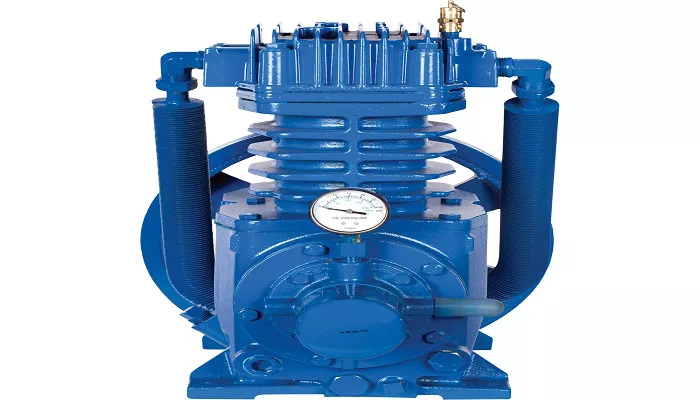Pumps and compressors are both mechanical devices designed to move fluids, but they serve different purposes and operate under different principles. While they may seem similar at first glance, their applications, working mechanisms, and design considerations vary significantly. This article provides a detailed comparison between pumps and compressors, covering their definitions, working principles, classifications, applications, and key differences.
Definition & Basic Function
What is a Pump?
A pump is a mechanical device that moves fluids (liquids or slurries) from one place to another by adding energy to the fluid. Pumps primarily increase the fluid’s pressure or kinetic energy to facilitate flow. They do not significantly alter the fluid’s density since liquids are nearly incompressible.
What is a Compressor?
A compressor is a machine that increases the pressure of a gas (or vapor) by reducing its volume. Unlike pumps, compressors work with compressible fluids (gases) and significantly increase the fluid’s density. Compressors are widely used in refrigeration, air conditioning, and industrial gas processing.
Working Principle Comparison
How Does a Pump Work?
- Dynamic (Centrifugal) Pumps: Use rotational energy (impellers) to accelerate the fluid, converting kinetic energy into pressure.
- Positive Displacement Pumps: Trap a fixed amount of fluid and force it into the discharge pipe (e.g., piston pumps, gear pumps).
Since liquids are incompressible, pumps mainly focus on flow rate (volume per unit time) rather than pressure changes.
How Does a Compressor Work?
- Dynamic (Centrifugal/Axial) Compressors: Use rotating impellers to accelerate gas and convert velocity into pressure.
- Positive Displacement Compressors: Trap gas in a chamber and reduce its volume (e.g., reciprocating, rotary screw compressors).
Unlike pumps, compressors deal with significant changes in gas density and temperature due to compression.
Classification & Types
Types of Pumps
Dynamic Pumps
- Centrifugal Pumps: Most common type, uses an impeller to move fluid.
- Axial Flow Pumps: Fluid flows parallel to the shaft (used in high-flow, low-pressure applications).
Positive Displacement Pumps
- Reciprocating Pumps: Use pistons or diaphragms (e.g., plunger pumps).
- Rotary Pumps: Use gears, lobes, or screws (e.g., gear pumps, peristaltic pumps).
Types of Compressors
Dynamic Compressors
- Centrifugal Compressors: Use a rotating impeller to increase gas velocity, then a diffuser to convert it into pressure.
- Axial Compressors: Gas flows parallel to the shaft, used in jet engines and high-capacity applications.
Positive Displacement Compressors
- Reciprocating Compressors: Use pistons to compress gas (common in industrial applications).
- Rotary Compressors: Include screw, vane, and scroll compressors (used in refrigeration and air systems).
Key Differences Between Pumps & Compressors
| Parameter | Pump | Compressor |
|---|---|---|
| Fluid Type | Liquids (incompressible) | Gases (compressible) |
| Primary Function | Moves fluid, increases flow/pressure | Increases gas pressure, reduces volume |
| Density Change | Negligible | Significant |
| Energy Consumption | Generally lower | Higher due to compression work |
| Temperature Effects | Minor temperature rise | Significant heating (adiabatic compression) |
| Design Complexity | Simpler for low-pressure systems | More complex (cooling systems needed) |
| Applications | Water supply, oil transfer, chemicals | Refrigeration, air conditioning, gas pipelines |
Applications in Industry
Common Pump Applications
- Water Supply & Irrigation: Centrifugal pumps in municipal water systems.
- Oil & Gas Industry: Gear pumps for fuel transfer, submersible pumps in wells.
- Chemical Processing: Diaphragm pumps for corrosive fluids.
- HVAC Systems: Circulating pumps for chilled water.
Common Compressor Applications
- Refrigeration & AC: Compressors in refrigerators and air conditioners.
- Industrial Gas Processing: Compressing natural gas, oxygen, nitrogen.
- Power Plants: Air compressors for combustion.
- Pneumatic Systems: Providing compressed air for tools and machinery.
Thermodynamic Considerations
Pumps & Hydraulic Efficiency
- Mechanical losses (bearing friction, seal leakage).
- Hydraulic losses (turbulence, impeller design).
Compressors & Thermodynamic Laws
- Isentropic Efficiency: How close the compression is to an ideal adiabatic process.
- Cooling Requirements: Intercoolers and aftercoolers reduce temperature rise.
- Pressure Ratio: Higher ratios require multi-stage compression.
Maintenance & Operational Challenges
Pump Maintenance Issues
- Cavitation: Vapor bubbles collapse, damaging impellers (caused by low suction pressure).
- Wear & Corrosion: Due to abrasive or corrosive fluids.
- Seal Leakage: Mechanical seals or packing wear over time.
Compressor Maintenance Issues
- Overheating: Due to high compression ratios, requiring cooling systems.
- Oil Contamination: In lubricated compressors, oil can mix with gas.
- Vibration & Pulsation: Especially in reciprocating compressors.
Selection Criteria: Pump vs. Compressor
When choosing between a pump and a compressor, engineers consider:
- Pressure Requirements: Compressors handle much higher pressures.
- Flow Rate: Pumps are better for high liquid flow rates.
- Energy Efficiency: Compressors consume more power.
- System Design: Pipes, valves, and cooling needs differ.
Conclusion
Understanding these differences ensures proper selection, operation, and maintenance in industrial and commercial applications. Engineers must carefully evaluate system requirements to choose the right machine for optimal performance and efficiency.

